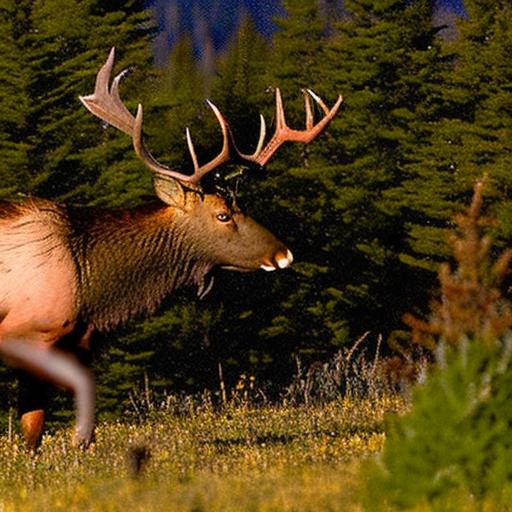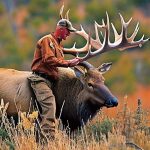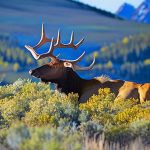Your cart is currently empty!

Chasing the Majestic: A Wisconsin Elk Hunt Adventure

Elk hunting in Wisconsin has a rich history that dates back to the early 1800s. At that time, elk were abundant in the state, but due to overhunting and habitat loss, their population declined rapidly. In the late 1800s, elk were completely extirpated from Wisconsin. However, in the mid-1990s, efforts were made to reintroduce elk to the state. Today, Wisconsin is home to a growing elk population and offers a limited hunting season for those who are lucky enough to obtain a tag.
The elk population in Wisconsin is carefully managed by the Department of Natural Resources (DNR). The hunting season is limited to a small number of tags, which are allocated through a lottery system. This ensures that the elk population remains stable and sustainable. The hunting season typically takes place in the fall, when the elk are in their rutting season and more active. It is an exciting time for hunters who have been waiting for their chance to pursue these majestic animals.
Key Takeaways
- Elk hunting is a popular and exciting activity in Wisconsin.
- Proper preparation, including obtaining licenses and gear, is essential for a successful hunt.
- Tracking and spotting elk requires skill and patience.
- Conservation and management efforts are crucial for the sustainability of elk populations.
- Hunting plays a role in wildlife management, but ethical and responsible practices are important.
Preparing for the Hunt: Gear, Licenses, and Regulations
Elk hunting requires specialized gear to ensure a successful and safe hunt. Some essential gear includes a high-powered rifle or bow, appropriate ammunition or arrows, camouflage clothing, binoculars or spotting scopes, a backpack for carrying gear, and a good pair of boots for traversing rugged terrain. It is important to invest in quality gear that will withstand the elements and provide comfort during long hours of hunting.
To participate in elk hunting in Wisconsin, hunters must obtain a hunting license and necessary permits. The application process begins several months before the hunting season and involves submitting an application online or by mail. The DNR then conducts a lottery to allocate tags to successful applicants. It is important to familiarize yourself with the application process and deadlines to ensure you have the best chance of obtaining a tag.
There are also regulations and restrictions that hunters must be aware of. These include specific hunting seasons and zones, bag limits, and legal hunting methods. It is crucial to thoroughly read and understand the hunting regulations provided by the DNR to ensure compliance and avoid any penalties. Conservation officers regularly patrol hunting areas to enforce these regulations and ensure the sustainability of the elk population.
The Thrill of the Chase: Tracking and Spotting Elk
Tracking and spotting elk is an art that requires patience, skill, and knowledge of their behavior and habitat. Elk are elusive animals that can cover large distances in a short amount of time. To increase your chances of success, it is important to learn how to track their movements and spot them in their natural habitat.
One tip for tracking elk is to look for signs such as tracks, droppings, rubs on trees, and wallows. These signs can indicate recent elk activity in the area. It is also helpful to study maps and topography to identify potential elk habitats such as meadows, valleys, and ridges. Elk are often found in areas with abundant food sources and water.
Understanding elk behavior is also crucial for a successful hunt. During the rutting season, bulls will bugle to attract cows and establish dominance. This can be a good indicator of their presence in the area. Elk are most active during early morning and late evening hours, so it is important to plan your hunts accordingly.
The excitement of the hunt lies in the unpredictability of encountering an elk. The adrenaline rush when you spot an elk in your sights is unmatched. It is a thrilling experience that keeps hunters coming back year after year.
The Importance of Conservation and Management
| Metrics | Importance |
|---|---|
| Biodiversity | Conservation and management of natural resources helps to preserve biodiversity, which is essential for the survival of various species and ecosystems. |
| Climate Change | Conservation and management of natural resources can help mitigate the effects of climate change by reducing greenhouse gas emissions and promoting sustainable practices. |
| Economic Benefits | Conservation and management of natural resources can provide economic benefits through ecotourism, sustainable agriculture, and other industries that rely on natural resources. |
| Human Health | Conservation and management of natural resources can improve human health by providing clean air and water, reducing exposure to toxins, and promoting physical activity and mental well-being. |
| Cultural Heritage | Conservation and management of natural resources can help preserve cultural heritage by protecting sacred sites, traditional knowledge, and cultural practices that are tied to the natural environment. |
Conservation plays a vital role in elk hunting in Wisconsin. The reintroduction of elk to the state was a result of conservation efforts aimed at restoring their population and preserving their natural habitat. The DNR closely monitors the elk population and implements management strategies to ensure their long-term survival.
Hunting is an important tool in managing wildlife populations, including elk. By carefully controlling the number of tags issued each year, the DNR can maintain a healthy and sustainable elk population. Hunting helps to prevent overpopulation, which can lead to habitat degradation and increased competition for resources.
Responsible hunting practices are also crucial for conservation. Hunters are required to follow regulations and restrictions to ensure the sustainability of the elk population. This includes harvesting only mature animals, respecting bag limits, and reporting harvest data to the DNR. By adhering to these practices, hunters contribute to the overall health and well-being of the elk population.
The Role of Hunting in Wildlife Management
Hunting plays a crucial role in wildlife management, including elk hunting in Wisconsin. It helps to control populations, prevent overgrazing, and maintain a healthy balance within ecosystems. Without hunting, wildlife populations can become imbalanced, leading to negative impacts on habitat and other species.
Hunters also play a significant role in conservation efforts. They contribute financially through the purchase of hunting licenses and permits, which fund conservation programs and habitat restoration projects. Additionally, hunters often volunteer their time and resources to assist with wildlife management activities such as habitat improvement, population surveys, and predator control.
The economic impact of hunting on local communities cannot be overlooked. Elk hunting brings in revenue through tourism, as hunters travel from near and far to pursue these magnificent animals. Local businesses benefit from increased sales of hunting gear, lodging, food, and other services. This economic boost helps support rural communities and contributes to their overall well-being.
The Challenges of Hunting Elk in Wisconsin

Hunting elk in Wisconsin presents several challenges that hunters must be prepared for. One of the main challenges is the weather. The hunting season takes place in the fall when temperatures can be unpredictable. It is important to dress in layers and be prepared for cold, wet, and windy conditions. The ability to withstand these challenging weather conditions is crucial for a successful hunt.
The terrain in Wisconsin can also be challenging. Elk are often found in rugged and remote areas, requiring hunters to navigate through dense forests, steep hillsides, and marshy terrain. Physical fitness is important for traversing these challenging landscapes and being able to keep up with the elk.
Mental preparation is equally important when hunting elk in Wisconsin. It can be a physically and mentally demanding pursuit that requires patience, perseverance, and determination. The ability to stay focused and maintain a positive mindset is crucial for a successful hunt.
Hunting Ethics and Responsible Hunting Practices
Ethical hunting practices are of utmost importance when pursuing elk in Wisconsin or any other game species. Hunters must respect wildlife and the environment, ensuring that their actions do not cause unnecessary harm or disturbance. This includes following all hunting regulations, harvesting animals ethically, and minimizing waste.
Responsible hunters also prioritize conservation and sustainability. They understand the importance of maintaining healthy populations and preserving natural habitats. They actively participate in conservation efforts by supporting organizations that work towards these goals and by practicing responsible hunting techniques.
Hunters have a unique connection to the natural world and play a vital role in promoting conservation and sustainability. By sharing their experiences and knowledge with others, they can inspire future generations to appreciate and protect our natural resources.
The Rewards of a Successful Elk Hunt
A successful elk hunt is incredibly rewarding on many levels. The satisfaction of harvesting your own meat is one of the most tangible rewards. Knowing where your food comes from and having a direct connection to the land is a powerful experience. Elk meat is lean, flavorful, and highly nutritious, making it a prized culinary delight.
The memories and experiences gained from an elk hunt are also invaluable. The camaraderie shared with fellow hunters, the thrill of the chase, and the beauty of the natural world all contribute to a memorable adventure. These experiences create lasting bonds and stories that are shared for years to come.
Sharing the Experience: Storytelling and Community
Sharing hunting experiences with others is an important part of hunting culture. Hunters often gather to share stories, swap tips and techniques, and relive their adventures. Storytelling is a way to pass down knowledge and traditions from one generation to the next. It helps to build a community of hunters and conservationists who share a common passion for the outdoors.
Building a community of hunters and conservationists is crucial for the future of hunting and wildlife management. By coming together, hunters can advocate for policies that support conservation efforts, promote ethical hunting practices, and ensure the sustainability of wildlife populations. This sense of community strengthens the bond between hunters and their shared commitment to preserving our natural resources.
Reflections on the Hunt: Lessons Learned and Future Adventures
Every hunt provides an opportunity for growth and learning. Reflecting on the hunt allows hunters to evaluate their successes and failures, identify areas for improvement, and set goals for future adventures. Whether it is honing tracking skills, improving marksmanship, or expanding knowledge of elk behavior, there is always room for growth in the pursuit of elk hunting.
Looking ahead, hunters often set new goals and aspirations for their hunting journeys. This may include pursuing other species, exploring new hunting grounds, or engaging in conservation efforts. The desire to continue learning and growing as a hunter and conservationist is what keeps the spirit of hunting alive.
In conclusion, elk hunting in Wisconsin offers a unique and thrilling experience for those lucky enough to participate. It requires careful preparation, knowledge of elk behavior and habitat, adherence to regulations and ethical hunting practices, and a deep appreciation for conservation efforts. The rewards of a successful hunt go beyond the harvest itself, encompassing the satisfaction of providing your own food, the memories and experiences gained, and the sense of community and connection to the natural world. As hunters continue to pursue their passion, they play a vital role in wildlife management and conservation, ensuring that future generations can also enjoy the thrill of the chase.
If you’re planning a Wisconsin elk hunt, you might also be interested in learning how to hunt groundhogs. Groundhogs can be a challenging and exciting target for hunters, and this article from Old Oak Syndicate provides valuable tips and techniques for a successful groundhog hunt. Check out the article here to enhance your hunting skills and expand your hunting experiences.
FAQs
What is the Wisconsin elk hunt?
The Wisconsin elk hunt is an annual event where licensed hunters are allowed to hunt elk in designated areas of Wisconsin.
When does the Wisconsin elk hunt take place?
The Wisconsin elk hunt typically takes place in the fall, usually in September or October.
How many elk are available for hunting in Wisconsin?
The number of elk available for hunting in Wisconsin varies from year to year, but typically ranges from 10 to 20.
How do I apply for a Wisconsin elk hunting license?
To apply for a Wisconsin elk hunting license, you must first purchase a Wisconsin hunting license and then apply for an elk hunting permit through the Wisconsin Department of Natural Resources.
What are the eligibility requirements for a Wisconsin elk hunting license?
To be eligible for a Wisconsin elk hunting license, you must be at least 12 years old and have a valid Wisconsin hunting license.
What is the cost of a Wisconsin elk hunting license?
The cost of a Wisconsin elk hunting license varies depending on the type of license and whether you are a resident or non-resident of Wisconsin. In general, the cost ranges from $10 to $1,000.
What are the hunting regulations for the Wisconsin elk hunt?
The hunting regulations for the Wisconsin elk hunt include restrictions on the type of weapons that can be used, the number of elk that can be harvested, and the areas where hunting is allowed. Hunters must also follow all state and federal hunting laws and regulations.

Herb has been a longtime lover of the outdoors. Whether it be hunting, camping, fishing or just getting outside to reset. Proud father and animal lover. Bourbon anyone?

by
Tags:
Comments

Categories
- Big Game Hunting (301)
- Deer (202)
- Reviews (3)
- Shooting (16)
- Slingshot (1)
- Small Game Hunting (42)
- Upland Hunting (126)
- Waterfowl Hunting (3)





Leave a Reply